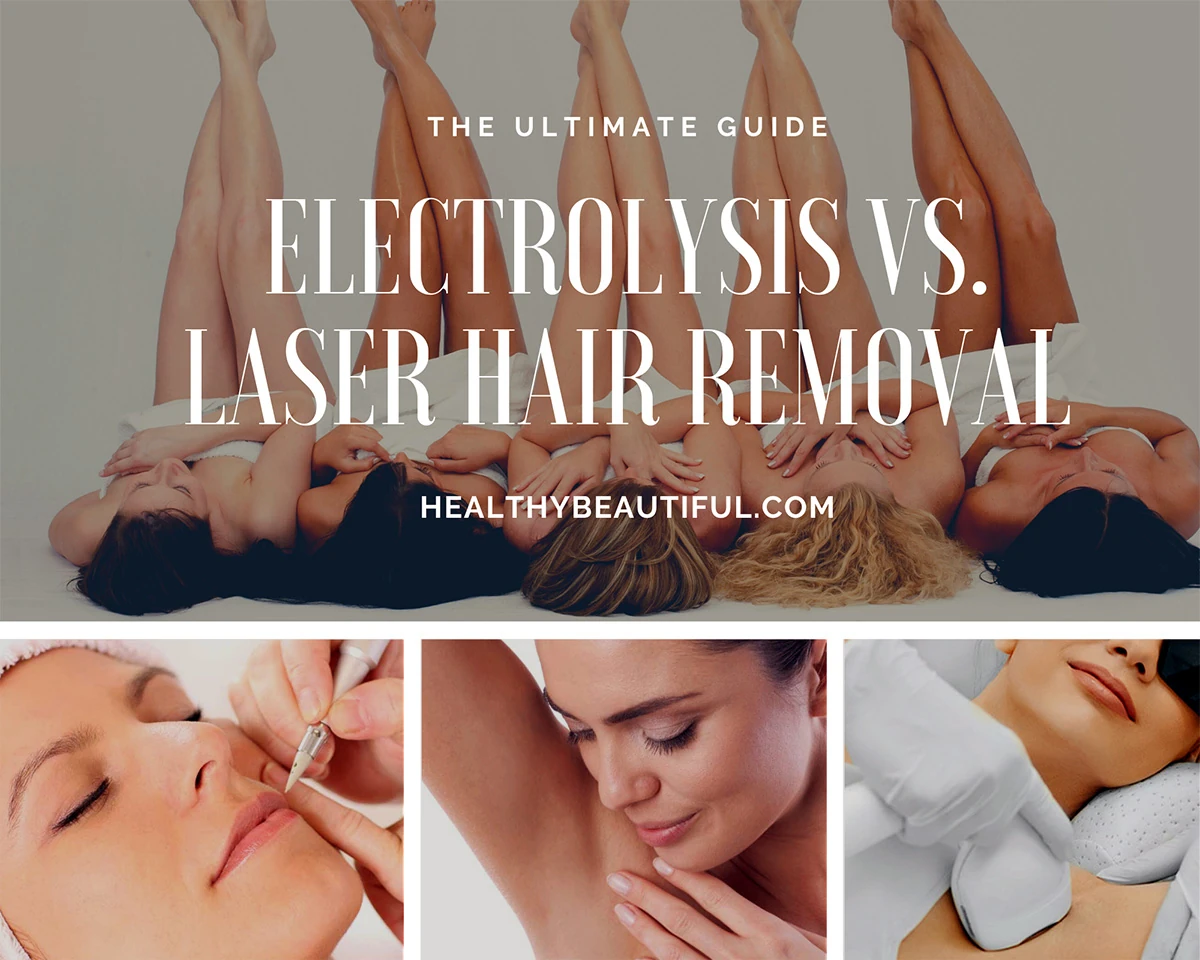Imagine Perfectly Smooth Skin with Permanent Hair Removal
The idea of never having to pluck, wax, or deal with ingrown hairs and infected follicles ever again is the dream.
The most prevalent clinical methods of permanently dealing with unwanted hair on any part of the face and body are electrolysis vs. laser hair removal.
Permanent hair removal is a lifetime investment and will require maintenance for most people.
This is why when you decide to finally do something about it, it's best to approach it with commitment and perseverance.
Our in-house estheticians and laser technicians discuss both types of hair removal in-depth to give you scientifically backed information and a wealth of experience in hair removal.
By the end of this article, you should be able to decide with confidence which method is right for you.

Ask the Expert: Electrolysis vs. Laser Hair Removal: Which is better for you?
BY SAMANTHA WELCH, ESTHETICIAN
Quick Answer: The treatment most suitable for you depends primarily on your hair color and other essential factors like your pain tolerance, hair resilience, treatment area, time, and cost.
- LASER HAIR REMOVAL should be the better option for most people with dark hair, who have low pain tolerance, have large areas to treat, and prefer a more affordable option.
It is approved by the FDA for “permanent hair reduction”—meaning hair re-growth is stunted or significantly thinned out for a considerable amount of time.[1] Re-growth may take anywhere from months to years after the first set of treatments. Afterwhich, you may need maintenance once or twice a year.
For those with dark skin, special requirements need to be observed.- If you're going to a clinic, make sure their machine uses nd:YAG or a long-pulsed diode. These are the safest lasers for dark skin. IPL will not work for you.
- For at-home users, there are only three (3) devices that we've tested that can treat darker complexions: the Silk'n Infinity, the Illuminage touch, and the ViQure EpiPro.
- ELECTROLYSIS can give you complete hair loss and is the only “permanent hair removal” procedure recognized by the FDA.
This option is better for people with light blonde, white, or grey hair or hirsutism, where IPL and laser can be ineffective. However, you will need a relatively high pain tolerance and hours set aside for every treatment.
If you decide on laser hair removal, you can opt for a clinic if you have the budget. If you're open to doing it at home, purchasing a personal laser device can be an excellent investment as you can get the same results.
If you decide on electrolysis, I recommend going to a professional electrologist instead. This procedure is highly technical, and the risk of scarring yourself is very high. This method can also be challenging and time-consuming with home devices and requires a reasonable amount of expertise to perform.
- Imagine Perfectly Smooth Skin with Permanent Hair Removal
- Ask the Expert: Electrolysis vs. Laser Hair Removal: Which is better for you?
- Comparison Table: Electrolysis vs. Laser Hair Removal
- What You Should Know: The Hair Cycle & Permanent Hair Removal
- The Difference Between Electrolysis & Laser Hair Removal
- Overview: Electrolysis vs. Laser Hair Removal for your Face & Body
- Electrolysis vs Laser Hair Removal for the Face
- Electrolysis vs Laser Hair Removal for the Body
- Cost & Price: Electrolysis vs. Laser Hair Removal
- Permanent Hair Removal for Men & Women: Compare Electrolysis vs. Laser
- Affordable Solutions: At-Home Laser Hair Removal
- Decisive FAQs & Review: Electrolysis
- Decisive FAQs & Review: Laser Hair Removal
- FAQ: Electrolysis vs. Laser Hair Removal
- Resources:
Comparison Table:
Electrolysis vs. Laser Hair Removal
| Electrolysis | Laser Hair Removal | |
| Effectivity | Permanent hair removal, 100% hair loss. | Permanent hair reduction, 80-90% hair loss with maintenance. Complete hair loss is possible with less resilient hair. |
| Compatibility | Any skin tone & hair color on all areas of the body. | Conditional: Hair needs to be darker than its surrounding skin for most machines. Darker skin tones need a laser called nd:YAG and needs specialty home devices like Silk'n Infinity. |
| Process | A small probe treats individual hair strands with a small electrical current, which destroys the areas that re-generate hair. The strand is detached and quickly pulled out after. | Laser/light produces a specific wavelength that goes under the skin, is absorbed by the hair, heating it, and disabling hair growth. Hair will fall out on its own in the next few days. |
| Cost / Price | Charged per hour, eg. $50/hr. Time depends on the volume of hair in the treated area and hair growth. | Professional Services: Charged per treatment area and type of laser, averages $143 per treatment. At-Home Devices: Ranges from $150-$500 per device with thousands to unlimited treatments. |
| Pain | Medium to high can be minimized with topical anesthetic | Small to medium, can be minimized with cooling gel or topical anesthetic |
| Side Effects | Skin can be bumpy with slight swelling and redness where the hair follicle has been removed. Scabbing can also occur as it heals in 3-4 days. | A bit of redness immediately after that fades in a few hours. If the laser is misused, it can result in burns, discolored skin, blisters, and swelling. |
| Time | Long and laborious as each hair strand is treated individually. Ranges from 15 mins for stray hairs to hours for large areas. | Relatively quick, as dozens of hair are treated with each laser pulse. 5-10 mins for the face, 10-20 mins for the body. |
| Frequency | Varies per person, but on average 30 sessions spanning an 18-month period. Starts weekly and becomes less frequent over time. | 3-6 treatments, 4-6 weeks apart for 6 months. Return as needed for maintenance. |
| Conclusion | Best for: Blonde, white, or grey hair; small areas, have a high tolerance for pain, hirsutism, have time to spare for treatments | Best for: Dark hair, coarse hairs, large areas, on a budget, quick treatments |
What You Should Know:
The Hair Cycle & Permanent Hair Removal
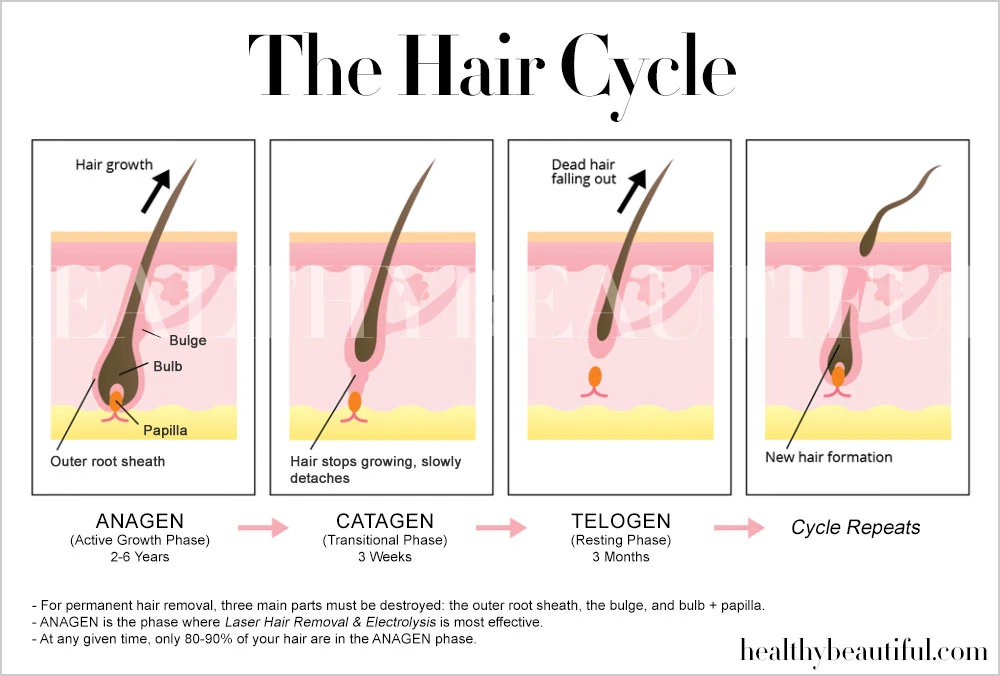
Key Points:
- This cycle of new hair formation is slowed down and debilitated for months to years when you undergo permanent hair reduction (i.e., LHR or laser hair removal). It is stopped entirely in permanent hair removal (i.e., electrolysis, and LHR if you have weak hair).
- These processes destroy the fundamental structures that regenerate hair: the bulge, the outer root sheath, and the bulb + papilla. Treatments must be done safely, without damaging the surrounding tissue.
- ANAGEN is the phase where laser hair removal & electrolysis is most effective. Only 80-90% of your hair is naturally in the ANAGEN phase at all times. (We grow and shed hair daily.) However, once you start your treatments, your hair cycle will begin to regrow in sync.
- Once your hair cycle is in sync, you'll be able to target more hair in the ANAGEN phase than usual. This is why keeping a strict schedule is necessary to see results.
- Hair growth can also be stimulated by varying factors like hormones and require multiple treatments to be fully destroyed.
The Difference Between Electrolysis & Laser Hair Removal
Most think that electrolysis is the same as laser hair removal as both are effective for the long-lasting removal of unwanted hair compared to temporary solutions like waxing or shaving.
The main difference between these hair removal treatments is the process, degree of pain, the type of hair it can remove, and the amount of hair loss expected.
Electrolysis
Electrolysis uses a fine needle with a small amount of electricity to zap and destroy hair growth cells. It is effective on all hair and skin types, and you can expect 100% permanent hair removal after several treatments.
However, this procedure is highly operator-dependent, can be quite painful for some, and patient efficacy in permanent hair removal varies. As a result, treating huge areas is frequently impractical.
Video: 2pass Clinic – What is electrolysis hair removal?
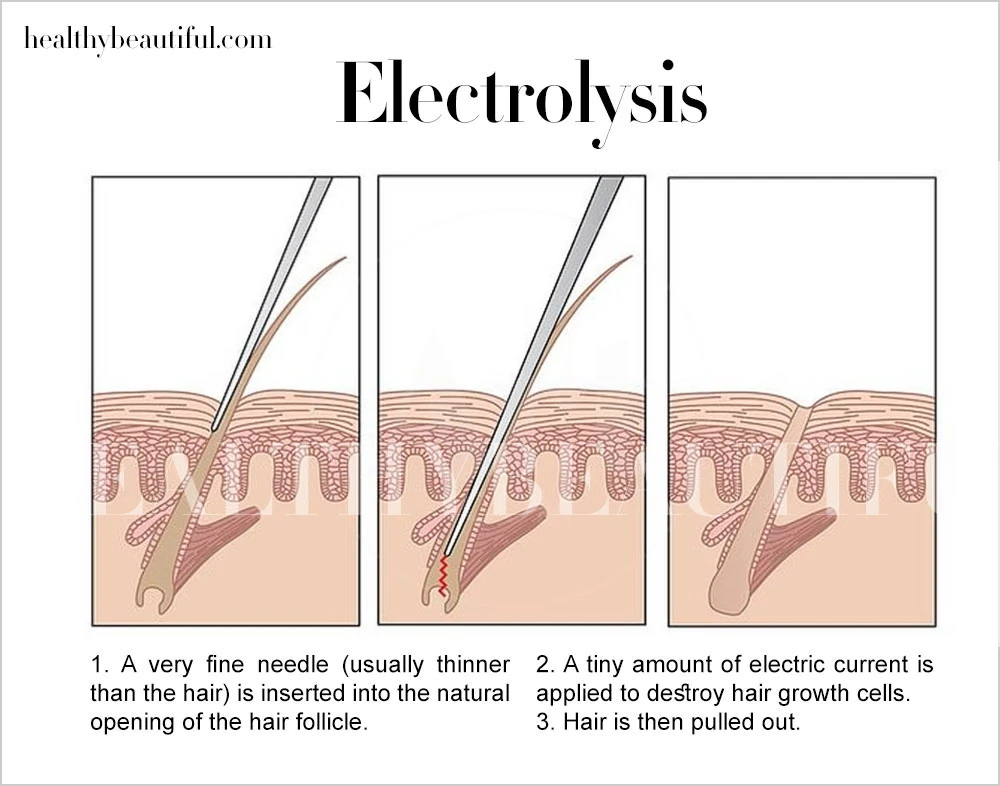
The Electrolysis Process:
- A very fine needle (usually thinner than the hair) is inserted into the natural opening of the hair follicle.
- A tiny amount of electric current is applied to destroy hair growth cells.
- Hair is then manually pulled out.
Laser Hair Removal
Laser hair removal uses light or a focused laser to beam heat to the hair follicle and damage it sufficiently to suppress re-growth. You can use most lasers on hair that's darker than your skin.
Darker skin color and lighter hair shades need unique technology like nd:YAG, galvanic, or radiofrequency.
Efficacy is at an 80-90% rate of permanent hair reduction. Permanent hair loss is possible if you have sufficiently damaged the hair growth cells enough to prevent another hair cycle.
The procedure is also very efficient, with a single flash treating multiple hairs at once. A session can last for only a few minutes.
Video: Laser hair removal: What to expect from the American Academy of Dermatology
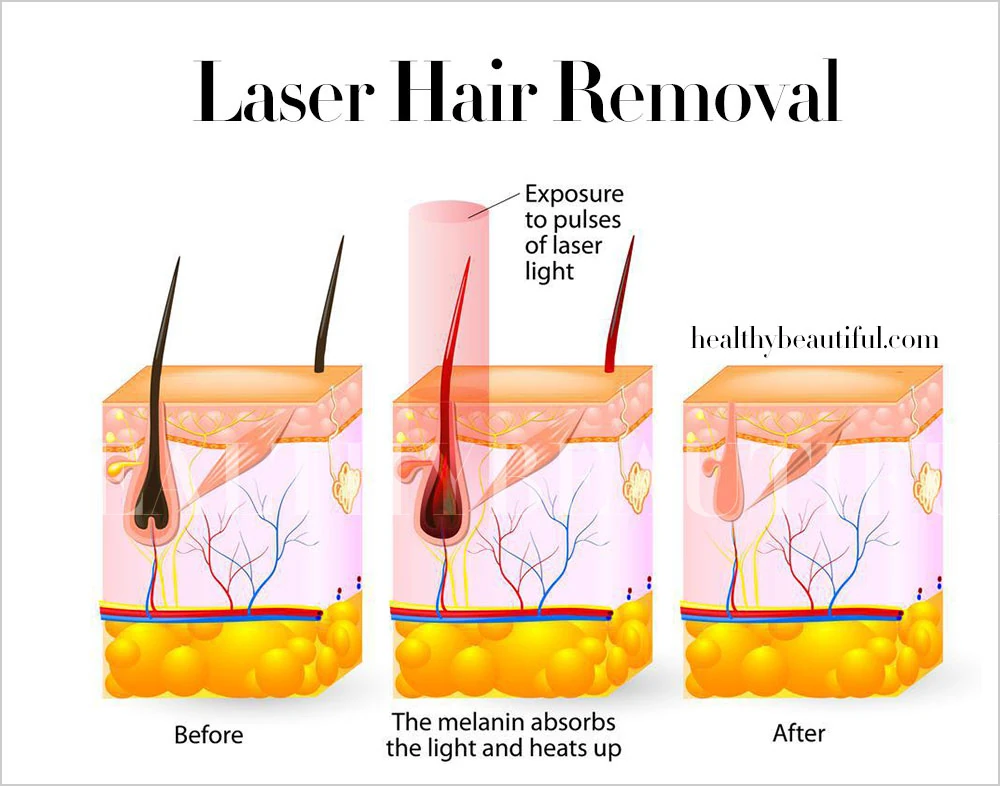
The Laser Hair Removal Process:
- The area is cooled with gel to protect the skin.
- Laser beams penetrate the skin, get absorbed by the hair, and are converted to heat.
- Heat damages the hair significantly, impeding its ability to re-grow.
Commonalities: How Electrolysis is like Laser Hair Removal
- Results: Both are considered to be long-term solutions to unwanted hair.
- Process: Both use energy (galvanic/electric current vs. laser/light) to destroy the same hair underneath the skin to prevent re-growth.
- Frequency: Both are progressive treatments and require multiple visits to see results.
- ANAGEN Phase: Treatments are most effective when the hair follicle is in its active phase. Since hair grows at different stages at any time, there will always be dormant hairs that you will be unable to treat during your sessions.
Differences: Electrolysis Compared to Laser Hair Removal
- Efficacy: Both are FDA approved, but electrolysis is the only procedure recognized as “permanent hair removal.” Laser hair removal is only approved as “permanent hair reduction.”
- Compatibility: Electrolysis can be done on any skin type and hair color. Hair types can also be a factor in efficacy. Fine hairs can be treated much more effectively with electrolysis.
Most laser hair removal machines require that hair be darker than the skin, thus not effective on white, grey, or light blonde hair. Only the nd:YAG laser and specialty devices that use radiofrequency or galvanic current with IPL can be used on darker skin tones. - Process: Laser works by targeting the melanin and destroying follicles with heat, while electrolysis uses a fine wire to pass a small electric current down the hair shaft to destroy the roots.
- Time: Laser hair removal is considerably quicker, with multiple hairs being treated at once, vs. electrolysis, where hair is treated individually.[2]
- Cost: Electrolysis is charged by the hour and largely depends on the hair volume. Laser hair removal is dependent mainly on the size of the treatment area and the type of laser/IPL used. For most people, laser hair removal will be the more cost-effective choice.
Reference: Laser Hair Removal Cost & Prices (National Statistics Report) vs. The Best At-Home Laser Hair Removal Devices - Pain: Electrolysis is more painful than laser hair removal, and is likely your best option if you have very low pain tolerance.
- Professional Services: While a board-certified dermatologist may be the usual option, performing these methods of hair removal requires different licenses. An electrologist needs electrology licensure by state and can also be certified by the International Commission for Hair Removal Certification (ICHRC). A laser hair removal technician also needs state licensure.
Overview: Electrolysis vs. Laser Hair Removal for your Face & Body
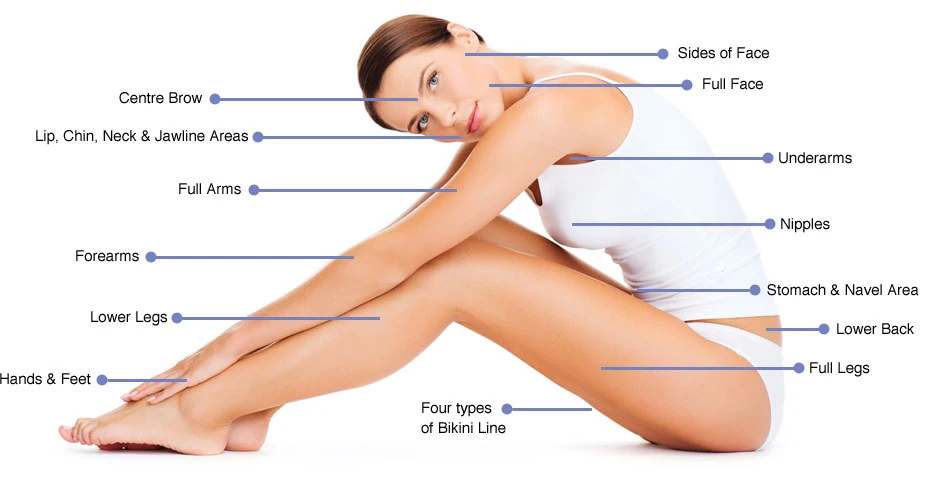
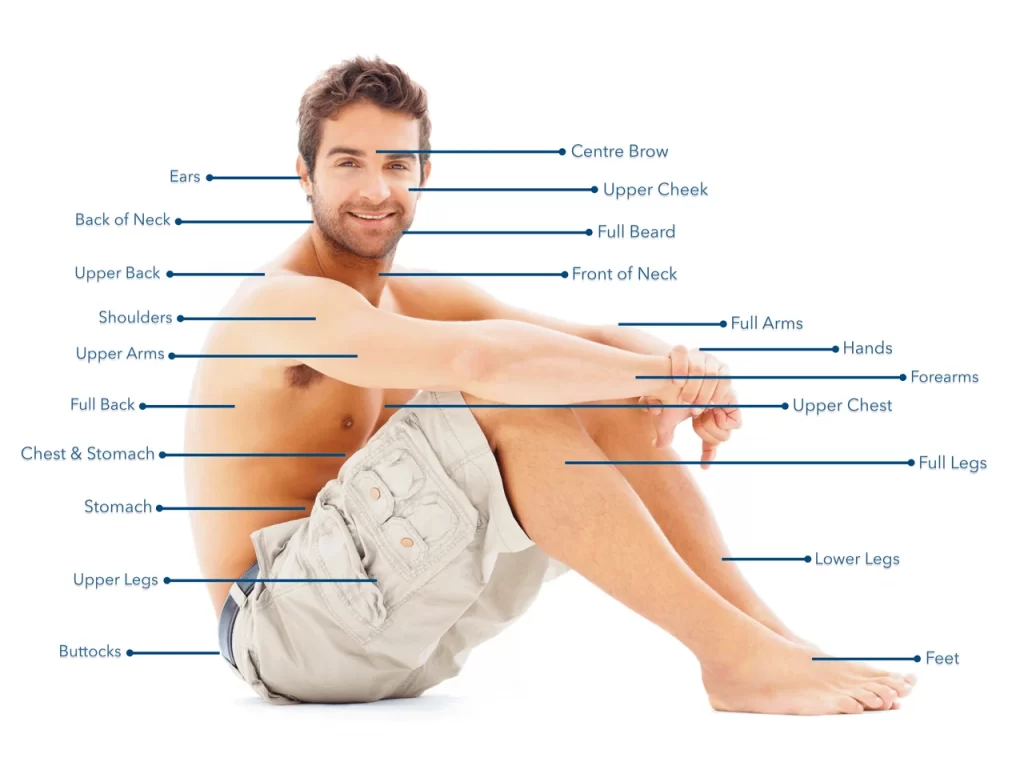
Best Areas for Electrolysis:
Very small areas, fine hairs, facial hair, hirsutism; white, blond, or grey hair
- Face (Eyebrows or Unibrow, Sideburns, Chin, Jaw) – Coarse hair, like mustaches on the upper lip, can also work great with laser hair removal, even with at-home laser devices.
- Fine hair or “peach fuzz” – laser usually cannot target the pigment in the vellus hair because it doesn't have enough melanin.
Best Areas for Laser Hair Removal:
Small & large areas from the cheekbones below will be cost-effective and time-efficient.
- Face (Eyebrows, Upper lip, Chin, Jaw, Sideburns)
- Ears
- Axilla or Underarm
- Back hairs
- Bikini area
- Brazilian & Pubic hair
- Arms & Legs
Electrolysis vs Laser Hair Removal for the Face
People dealing with unwanted facial hair know that it is one of the most embarrassing and frustrating parts of puberty.
I was 14 when I started having it, unknowingly as a side-effect of PCOS.
It made me terribly anxious and insecure. I felt like everyone was always staring at my “mustache” or “beard.”
Most of us have tried everything from shaving to threading and waxing.
Unfortunately, this comes with ingrown hairs, pimples (folliculitis or infected follicles), hyperpigmentation, redness, sensitivity, and textured skin—the list is endless.
We realize sooner or later that this cycle of consistently damaging our skin week after week is NOT sustainable.
It is an inconvenience at best and (literally) scarring at worst.
When we look at permanent solutions, we ultimately end up with laser vs electrolysis for facial hair removal.
Which method is best comes down to what area you're looking to treat and which is most suitable for your lifestyle.
- Electrolysis is more permanent than laser but can be extremely painful and time-consuming.
- Laser is more convenient in general but can be less effective than electrolysis, especially with hormone-related issues.
Whether you opt for professional services or at-home laser hair removal and personal electrolysis, you must remember to always be consistent with your schedule.
Permanent hair removal is a compounded system that destroys your hair roots and prevents your hair growth cells from renewing their cycle.
This doesn't happen in just one or two sessions, but with continuous effort for months.
By your 4-5th session, you'll notice your hair starting to clear up. Fewer and thinner, with longer waiting times for hair to grow back.
Some clinics will ask you not to shave so they can assess the progress and adjust their approach accordingly.
This is up to you if you can stand that in-between, but this is one of the best arguments for at-home hair removal.
Nothing beats the convenience of doing it whenever you want, in the comfort of your own home, especially during COVID.
Our hair can be very resilient to damage, so you mustn't give it time to recover.
It won't matter in the end what hair removal you choose if you miss your appointments and give it time to heal itself.
Permanent hair removal is a lifetime investment and will require maintenance for most people.
This is why when you decide to finally do something about it, it's best to approach it with commitment and perseverance.
Just imagine perfectly clear skin. No stray hairs on your face, ingrown hairs, or rough skin.
Permanent hair removal can boost your confidence, return your lost time, and eliminate the pain and effort of dealing with unwanted facial hair.
Eyebrows & Unibrow
Wouldn't it be great to no longer have to groom your eyebrows ever again?
No more tweezing, threading, or microblading?
Both electrolysis and laser hair removal can target errant hair between the brows, underneath the arch, and above it.
It's recommended to anyone with thick eyebrows, bushy brows, unibrows, or fast hair growth.
Electrolysis can work on all hair colors and skin types. Laser hair removal cannot work on grey or white hair and needs a particular laser for dark skin.
The skin around the eyebrows is thin, and hairs have short roots, making it quick work for both types of hair removal.
Video: An overview of electrolysis vs laser eyebrow hair removal.
Electrolysis is more precise but can be more painful and time-consuming than laser hair removal.
There are home electrology kits and at-home laser hair removal devices available.
Still, eyebrows should only be done by professionals. It is the most delicate area of the body that can be treated for hair removal, being so close to the eyes.
At-home devices can only work below the cheekbones.
Video: Example of blend electrolysis on a unibrow.
If you're opting for laser hair removal, you should get a professional specializing in eyebrow shaping or brow sculpting.
Video: Example of a clinic specializing in laser hair removal and eyebrow sculpting.
Even though professionals use a specialized laser tip for eyebrows, one little miss-zap can really do a lot of damage. (We want no less than PERFECT brows, please!) Eyebrows are also harder to grow back.
If your electrologist or laser technician specializes in brow sculpting, you can leave the design of your brows in their hands.
If not, you can get them shaped by your go-to brow professional who does threading or microblading.
When your wayward hairs start to grow is the time to go see your electrologist or esthetician and ask them to maintain the line.
An electrologist takes about 15-30 minutes each session, while an esthetician takes 10-15 minutes for eyebrows.
Once done, you wait about roughly a month or until the next hair cycle.
You'll begin to notice your hairs getting fewer and thinner. Your time between visits will also get longer until you don't have to go back.
You need to prep your hair by not waxing, plucking, or threading before and after treatments.
You also shouldn't pull the roots of your hair until they're in the optimal growth stage for your sessions.
Permanent hair removal takes anywhere from less than a year to a year and a half.
Key Points: Electrolysis vs Laser Hair Removal on Eyebrows
- Both can be used effectively for permanent hair removal or reduction.
- Electrolysis can work on all skin tones and hair colors, while laser hair removal cannot be used on white or grey hair.
- Eyebrows are delicate areas and can only be done by professionals, not DIY home devices.
- Professional electrolysis on unibrows averages around 15-30 mins, while laser hair removal takes only about 10-15 minutes.
- Visits start monthly and taper off as your hair gets thinner and fewer.
- Permanent hair removal takes anywhere from less than a year to a year and a half.
Upper Lip or Mustache
The upper lip is where patients commonly have unwanted facial hair.
We have upper lip + chin & jaw packages at the clinic because these usually come together.
Choosing electrolysis or laser hair removal for your upper lip depends on the thickness of your hair and your pain tolerance.
The upper lip is one of the most delicate parts for facial hair removal, second only to the eyebrows.
It can be especially painful treating the philtrum or the middle area.
You need to find a very good electrologist who uses great technology (I personally prefer blend) for a more comfortable treatment.
Topical anesthetics are a must. The numbing agent can help significantly with the experience.
Video: Electrolysis For (Lip Hair)
Electrolysis for the upper lip should take around 15-30 minutes for thermolysis and 30-40 minutes for blend. This is in addition to the 20-30 minute wait time for the topical anesthetic to kick in.
Laser hair removal is around 10 minutes overall on average.
What makes the upper lip different from other body parts is that hairs here grow very fast, just between 10-14 days.
This means you'll need to do sessions more frequently to catch your hair in its most vulnerable stage, the anagen.
This is where at-home laser hair removal is very convenient. You can do it quickly with less pain, time investment, and money to spend.
The ideal device would be something like the ViQure EpiPro, which is extremely powerful and has settings specifically for the face.
Video: I GOT LASER HAIR REMOVAL ON MY LIP AND CHIN | PCOS | SPADERMA CHICAGO
Key Points: Upper Lip Hair Removal Laser vs. Electrolysis
- One of the body's most delicate areas for hair removal next to the eyebrows.
- Electrolysis can be painful with an extended waiting time because of the topical anesthetic.
- Laser hair removal is preferred because it is gentler and quicker.
- Upper lip hair grows quickly, with just 10-14 days of re-growth.
- At-home laser hair removal will be highly convenient because of the frequency of treatments needed.
Chin, Jaw, & Sideburns
Based on the hundreds of clients I've had over the years, chin hair is the #1 most distressing issue most women come in for.
These are not your thin “peach fuzz” vellus hairs but thick and coarse beards that cross over to your sideburns.
Some women start to have them at puberty. Some have a sudden increase in hair growth from having just a few strays. Some experience a gradual and insistent proliferation of unwanted facial hair as time goes by.
It can be just the chin or continue upwards to the jaw, cheeks, sideburns, and down the neck.
Hair growth in this particular area is strong and tough to deal with.
Video: Laser Hair Removal Results | Pictures, How much, How long, Does it Hurt?
Whatever the cause, the solution remains the same:
- Permanent hair removal through electrolysis or high-intensity laser hair removal.
- Stopping any temporary hair removal that pulls the roots and stimulates hair growth like plucking, tweezing, threading, or waxing. Shaving is the only neutral method where it doesn't make it worse.
- If caused by a condition like hirsutism, concurrent medical management may be needed. You can talk to your doctor about PCOS, adrenal gland issues, or other medications that could be contributing to your excessive hair growth.
Whatever you do: DO NOT PLUCK, TWEEZE, THREAD, OR WAX.
It has been scientifically proven that specific types of follicle injury can trigger regeneration in your hair growth cells up to 5x in the surrounding area. This means that when hairs are plucked in a certain pattern, your follicles can signal the surrounding area, leading to even more hairs growing back.[1]
This particular study for alopecia had 200 plucked hairs trigger 1,200 new follicles in regrowth.
We want the complete opposite: to destroy your hair roots entirely, including any hair growth cells that could trigger this biological regeneration response.
This means powerful approaches in both electrolysis vs laser hair removal for chin hair, beards, and sideburns must be used consistent with the severity of your case.
We're looking at 18-24 months in regular visits for electrolysis and laser hair removal.
The frequency is between 4-8 weeks, determined by your severity.
Laser Hair Removal can be your first option as it is more affordable and can be effective for most people. You have to make sure that if it is caused by a medical condition like hirsutism, you pair it with a hormone-balancing regimen.
Video: Laser Zaps Out Ingrown Hairs from the Chin and Jaw
For at-home laser hair removal, I can only recommend the ViQure EpiPro as it is the only true laser, i.e. not IPL, and the most powerful of all devices. You can pair it with a numbing cream similar to professional treatments if you have a low pain threshold.
For the outliers where laser hair removal was not 100% effective, you can try electrolysis.
Electrolysis can be more effective than laser, but I would consider it as a last resort as it is more painful, time-consuming, and can be more expensive in the long run.
You can have electrolysis to sort out the last bits of hair that were left from your laser hair removal.
Video: Electrolysis hair removal for the chin, Close up
Ears & Earlobes
While unwanted ear hair can be a problem for both men and women, this is more common in men past 35.
You'll slowly notice hairs that were once benign start to become thick and coarse.
Unruly strands can be at the rim, at the back of ear lobes, or inside the ears, while some have the whole ridge lined with thick, coarse hair.
It's essential to address this as soon as possible because it will only worsen as you age.
It's also important not to get into the habit of tweezing out stray hairs because that can trigger even more hair growth.[1]
And while hairs can be thick and coarse, the skin of the earlobe itself is very thin. This means the roots of your hair are shallow, and laser vs electrolysis for ear hair removal will be easy.
If you have a lot of hair, laser hair removal is the more convenient solution.
You can treat the entire area in one go instead of individual hairs in electrolysis.
You can go to a professional clinic or have it done via at-home laser hair removal.
Video: Electrolysis Ear Hair Removal Issues
Your hair will start to thin out and fade as you continue your treatments.
Once you've finished a series of treatments, you may have to come back in a few months or years for maintenance.
Electrolysis can be a more permanent solution if you only have a few stray hairs you want gone.
Depending on the volume of stray hairs, it can take 15 minutes to an hour by electrolysis. It can take up to a year for permanent hair removal.
It's also possible to do both. Once you're cleared most of your hair via laser hair removal, you can sort the remaining few permanently through electrolysis.
But you'll have to decide soon because once these hairs turn white or grey, it will be too later for the laser. By then, your only option would be electrolysis.
Men's Beard, Neck & Throat
Ingrown hair, razor bumps, and skin irritation are just some of the problems that can arise when you shave every day.
These are the issues that most men would like to address when they get hair removal on their beards, neck, and throat.
Permanent hair removal also makes their daily grooming more efficient. It's easier to maintain the beard shape once stray hairs are taken care of.
Video: LASER HAIR REMOVAL FOR MEN | DOES IT HURT? ALEX COSTA
Laser hair removal is a much more efficient method because the hairs are thick and coarse.
When you come in for treatment, it's best to shave your beard to your preferred shape. You'll also likely be given a white marker to set the lines where you'd like to keep your hair.
After your series of sessions, you may come in once or twice a year for maintenance.
You can also do this at home with a laser hair removal device to do your treatments as often as needed.
Alternatively, you can also go for electrolysis for a more permanent result.
However, this can be a tedious process as these hairs are strong and plentiful. Dealing with each individual strand takes time and commitment.
Video: Electrolysis On Man Beard
Doing both can be a viable solution as well. You can start with laser, and sort the remaining hair with electrolysis.
Electrolysis vs Laser Hair Removal for the Body
When having hair removal for the body, most women want their legs and underarms done, while men target their back and shoulders.
When comparing electrolysis vs laser hair removal for the body, large areas are more convenient to treat via laser hair removal overall.
Most people also don't necessarily want to get rid of every single hair on their bodies. (We need it for thermoregulation!)
We just want to reduce its density, coarseness, and thickness.
After a few laser hair removal sessions, your body hair will be reduced to a light, short, fine “peach fuzz.” This result is already sufficient for most people.
With this in mind, there's no need to spend over 30+ hours of electrolysis treatments when you can be sorted with 30 minutes of laser hair removal every month.
You can go to a professional esthetician or laser technician to have this done, or you can buy an at-home laser hair removal to do your treatments anytime and at the convenience of your home.
Back & Shoulders, Lower Back
Most men come in for hair removal on their backs and shoulders.
Lower back hair is something that particularly women who have PCOS develop.
For laser vs electrolysis back hair removal, large areas like this are best suited for laser.
Video: Men's Laser Hair Removal On Shoulders And Back With Brandon Skeie | LaserAway
Electrolysis is a tedious process in small areas. It is not efficient or practical for large areas like the shoulder and back.
Some people also don't necessarily want to be completely hairless but to minimize thick and unruly hair in these areas.
You can look sleek and well-groomed with laser hair reduction.
Treatments take around 30 minutes, with 8-10 visits in total. Your hair will gradually get thinner and more refined with each session.
You can have this done by a professional, or you can buy a laser hair removal device to do your treatments at home.
You won't be able to do this alone, though, so you'll have to enlist someone to help you with your back hair removal every month.
Underarms / Axilla / Armpits
Armpit hair may be the exception in the underarm hair removal laser vs electrolysis comparison.
It's a small enough area to be reasonably treated with electrolysis. Most people also want to be completely hairless in this area.
My advice is to get laser hair removal first and have it reduce most of the volume and thickness.
Video: Getting Laser Hair Removal On My Armpits!
15-20 minutes max per visit to a clinic, with 6-8 treatments for permanent hair reduction.
Alternatively, you can opt for an at-home laser device and continue your maintenance every few months.
After you've finished your series of treatments and want more than hair reduction, you can go to an electrologist and clear out the fuzz or any stray hairs.
Your electrologist can take 4-6 hours to finish the job, depending on the mode of treatment they use and their speed.
If you're extra hairy or not a candidate for laser, it will take 12-26 hours at the electrologist's clinic if you were to start from scratch.
It can also be painful because the axilla is a very sensitive area. You can use a numbing cream to make yourself more comfortable during your sessions.
Video: In Action: Underarms (Electrolysis Hair Removal)
One of the most underrated effects of no longer having to shave your underarms is: that you smell better. The pheromones that usually stick to your follicles won't be there, so there is less bacterial growth.
I personally don't have to use deodorant regularly anymore, save for specific occasions.
You will also get fewer side effects from waxing and shaving, like skin darkening and ingrown hairs.
Arms & Legs
Electrolysis vs laser hair removal on the legs and arms is a fairly straightforward debate.
We know that large body areas are best treated through laser hair removal.
It is fast and efficient and takes 30-45 minutes for each session. Laser hair removal will take 8-12 monthly in-clinic visits to complete, spanning a year.
Video: Laser Hair Removal (Arms) | Geria Dermatology
Alternatively, you can buy a home laser hair removal device to do this as often as possible at the convenience of your home.
Arm and leg hairs are done through electrolysis in sections, preferably about an hour each. You start with the back of the leg and gradually work your way around and below, then repeat until cleared.
This process is time-consuming and can add up price-wise.
Video: Laser Hair Removal (Arms) | Geria Dermatology
It's much more cost-effective and time-efficient to reduce as much hair as possible through laser hair removal.
Afterward, suppose your hair reduction is not enough, and you want to be completely hairless. In that case, you can clean the rest up with electrolysis.
Bikini Area
Electrolysis vs laser hair removal in the bikini area is straightforward as well.
If you have dark hair, best start with laser hair removal and finish any strays off with electrolysis.
This is the most effective, economical, and time-efficient saving way to permanently get rid of hair in your bikini area.
Video: Electrolysis Bikini Area Hair Removal
Hairs in the genital area are deeper and stronger, so they may take a while to go away.
It can take 10-12 monthly visits to the clinic via laser hair removal to achieve significant hair reduction.
You can also do this through laser hair devices, so you can start doing it every week instead and in the comfort of your home.
Video: Laser Hair Removal Bikini: THIS is how it works
Starting electrolysis without laser first will take an extraordinarily long time. You'll get an hour every month to treat a section, then farther in between as hair growth slows.
It can take you 3-4 years total for permanent hair removal.
You can expedite this timeline by opting to take an entire laser hair removal treatment course, then cap with electrolysis if you wish.
It can also be painful because the hairs are deep-seated and coarse. You'll need to use numbing cream to make your treatments more comfortable.
Brazilian & Genital Hair
It’s very similar to how the bikini area is treated, except the area to be treated is more thorough and goes through the back.
Numbing cream is applied on both electrolysis and laser hair removal because these are very sensitive areas.
Laser hair removal takes around 20-30 minutes each session. You come back in total for 8-12 treatments monthly to see significant results.
IPL devices aren't equipped for full Brazilian. The only at-home device cleared for Brazilian is the ViQure EpiPro, as it uses diode laser and requires a cooling gel to facilitate the process.
Video: Brazilian Laser Hair Removal | What to expect from your first session, results, preparation etc!
Electrolysis clears hairs in sections and takes up to an hour each. You come back roughly monthly as well, with sessions taking longer as hair begins to slow down.
And while this may be permanent, it can take an extraordinary 3-4 years in total.
It’s best to go for laser hair removal first, then finish off with electrolysis if you want a more permanent solution.
Cost & Price:
Electrolysis vs. Laser Hair Removal
Electrolysis: By the hour
You will be charged by the hour in electrolysis, e.g., $50/hour. This pricing is based on the laborious process of treating one individual hair strand at a time. The length of time will depend on the volume of hair, size of the treatment area, quality of the practice, and clinic location.
Here is an example of an electrolysis pricing chart:
| Treatment Time | Price |
| 15 minutes | $40 |
| 30 minutes | $60 |
| 45 minutes | $80 |
| 60 minutes | $100 |
Laser Hair Removal: By treatment area size
In laser hair removal, you will be charged by: the size of the treatment area, type of laser machine used, quality of the practice, and clinic location. Prices are very competitive, especially in certain cities.
Here is an example of a laser hair removal pricing chart:
| Treatment Area | Price per Visit |
| Upper lip / Chin / Sideburns | $100 |
| Beard | $200 |
| Chest | $300 |
| Underarms | $200 |
For nationwide rates, please refer to the Laser Hair Removal Cost (National Statistics Report).
Permanent Hair Removal for Men & Women:
Compare Electrolysis vs. Laser
Video: Laser Hair Removal vs. Electrolysis – Which is Better? by Divine Spa
Electrolysis has been around since 1875 and is the only method approved by the FDA for “permanent hair removal”. Every hair strand is treated, and 100% hair loss is more plausible with this method in ideal circumstances.
Electrolysis permanent hair removal treatments are still around, but limiting factors like pain, cost, and time have made it less popular as new technologies emerge.
Laser hair removal came to be in the 1980s and can only be marketed for “permanent hair reduction.” It can reduce hair up to 80-90% for most cases, but the hair would also be so thin and sparse at the end of the treatment that these results would satisfy most people.
In addition to its affordability and accessibility, this high satisfaction rating makes laser hair removal one of the leading treatments for unwanted hair.
There is currently no permanent hair removal without laser or electrolysis.
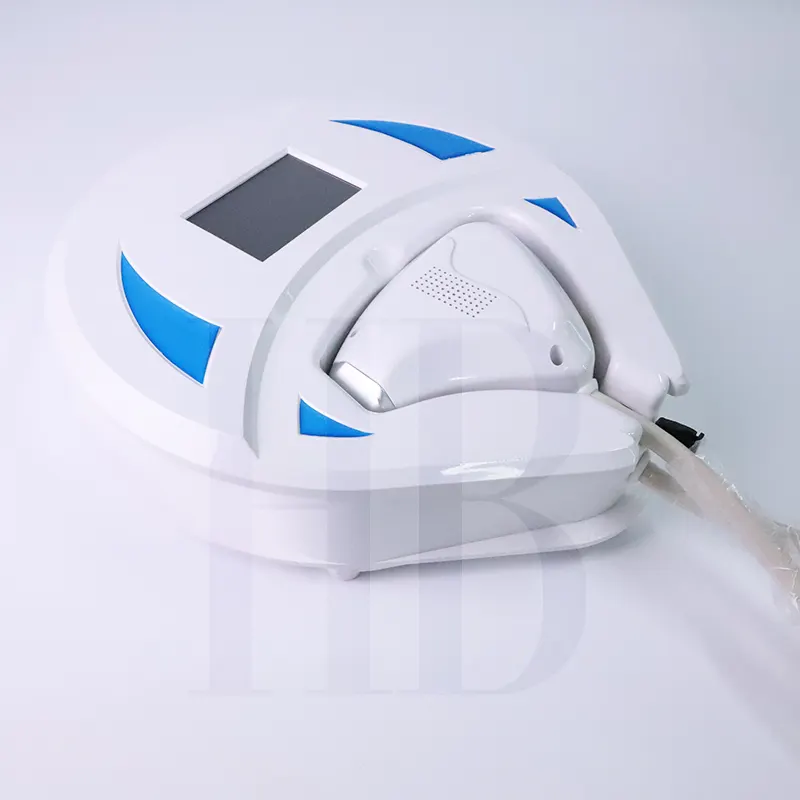
Affordable Solutions:
At-Home Laser Hair Removal
An alternative solution for permanent hair reduction is at-home laser hair removal devices.
Most of them use laser or IPL as the laser/light source and can be effective in addressing normal unwanted hair issues.
This method of hair removal is convenient and cost-effective for most people.
Decisive FAQs & Review:
Electrolysis
Is Electrolysis the Best Hair Removal Method? | The SASS with Susan and Sharzad
Electrolysis Pros and Cons
Pros:
- Guaranteed permanent hair removal as the aim is to completely destroy the root of the hair, which causes re-growth
- Suitable for any skin color and any type of hair; unlike laser hair removal which comes with certain limitations (eg. No white, blond, or grey hair, hard to work on fine hairs, etc.)
- Suitable for all areas of the body
Cons:
- The process can be significantly painful compared to laser hair removal and other hair removal methods
- Takes a significantly longer treatment time since each strand of hair must be treated
- It will be very costly for thicker hair as electrologists charge by the hour
- Requires much more treatments in total compared to laser hair removal
Electrolysis Hair Removal Before and After
Electrolysis Cases: Before & After
Decisive FAQs & Review:
Laser Hair Removal
How To Laser Hair Removal For Women | My Laser Hair Removal Journey | Eman
Laser Hair Removal Pros and Cons
Pros:
- A non-invasive procedure with minimal discomfort
- More efficient for larger areas like the back and legs because it treats hair by scale instead of individually
- At-home laser devices are now available in the market for an even more affordable solution
- Time: Takes significantly less time to do compared to electrolysis
- Frequency: Requires fewer treatments than electrolysis to complete a series
- Cost: Cheaper than electrolysis, especially for people with thick hair.
Cons:
- Can reduce hair to only 80-90% in most cases, and require maintenance thereafter.
- Compatibility: Not all people are good candidates for laser hair removal. People with dark skin can only be treated by a specific laser called Nd:YAG, which is not available in every clinic or spa. People with white, blonde, or grey hair won’t be treated effectively at all.
- The side effects of laser hair removal can be seen more often because of mishandling by non-professionals
Laser Hair Removal Before and After

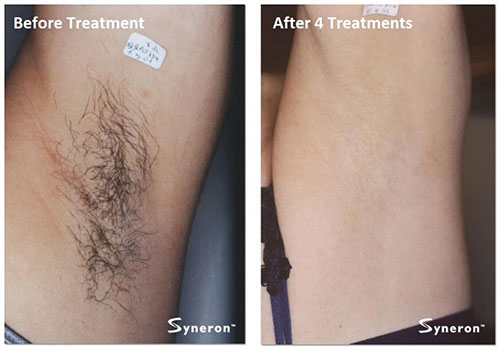
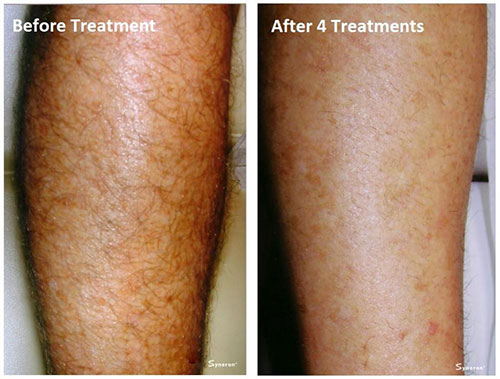
Photos courtesy of Venus Concept & Candela Medical.
FAQ: Electrolysis vs. Laser Hair Removal
Resources:
- Gupta G. Diode laser: Permanent hair “Reduction” Not “Removal”. Int J Trichol [serial online] 2014 [cited 2022 Feb 27];6:34. Available from: https://www.ijtrichology.com/text.asp?2014/6/1/34/136762
- David J Goldberg, Laser hair removal, Dermatologic Clinics, Volume 20, Issue 3, 2002, Pages 561-567, ISSN 0733-8635, https://doi.org/10.1016/S0733-8635(02)00019-0. (https://www.sciencedirect.com/science/article/pii/S0733863502000190)
- Electrolysis permanent hair removal | American Electrology Association. (2019).
- Bode, D., Seehusen, D., & Baird, D. (2019). Hirsutism in Women.
- Chan CS, Dover JS. Nd:YAG laser hair removal in Fitzpatrick skin types IV to VI. J Drugs Dermatol. 2013 Mar;12(3):366-7.
- Dierickx CC. Hair removal by lasers and intense pulsed light sources. Dermatol Clin. 2002 Jan;20(1):135-46.
- Garcia C, Alamoudi H, Nakib M, Zimmo S. Alexandrite laser hair removal is safe for Fitzpatrick skin types IV-VI. Dermatol Surg. 2000 Feb;26(2):130-4.
- Goldberg DJ. Laser hair removal. Dermatol Clin. 2002 Jul;20(3):561-7.
- Hussain M, Polnikorn N, Goldberg DJ. Laser-assisted hair removal in Asian skin: efficacy, complications, and the effect of single versus multiple treatments. Dermatol Surg. 2003 Mar;29(3):249-54
- Laser Hair Removal | Candela Medical. (2019).
- Lask G, Elman M, Slatkine M, Waldman A, Rozenberg Z. Laser-assisted hair removal by selective photothermolysis. Preliminary results. Dermatol Surg. 1997 Sep;23(9):737-9.
- McDaniel DH, Lord J, Ash K, Newman J, Zukowski M. Laser hair removal: a review and report on the use of the long-pulsed alexandrite laser for hair reduction of the upper lip, leg, back, and bikini region. Dermatol Surg. 1999 Jun;25(6):425-30.
- Removing Hairs Safely. (2019).
- Sadick NS, Weiss RA, Shea CR, Nagel H, Nicholson J, Prieto VG. Long-term photoepilation using a broad-spectrum intense pulsed light source. Arch Dermatol. 2000 Nov;136(11):1336-40.
- Venus Velocity Laser Hair Removal Device | Venus Concept USA. (2019).
- Wagner, R., Tornich, J., & Grande, D. (1985). Electrolysis and thermolysis for permanent hair removal. Journal Of The American Academy Of Dermatology, 12(3), 441-449. doi: 10.1016/s0190-9622(85)70062-x

